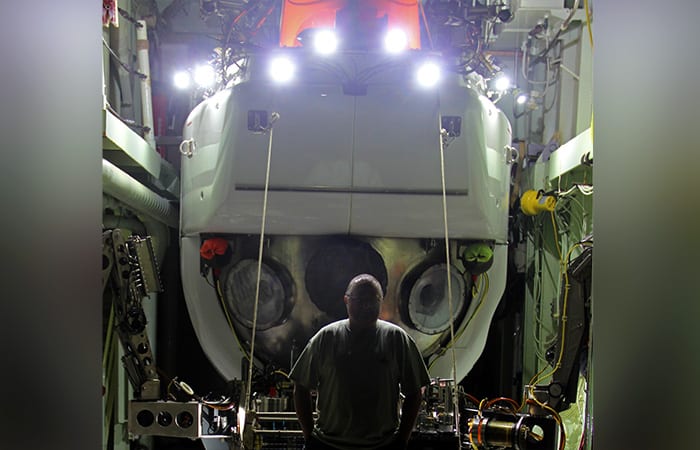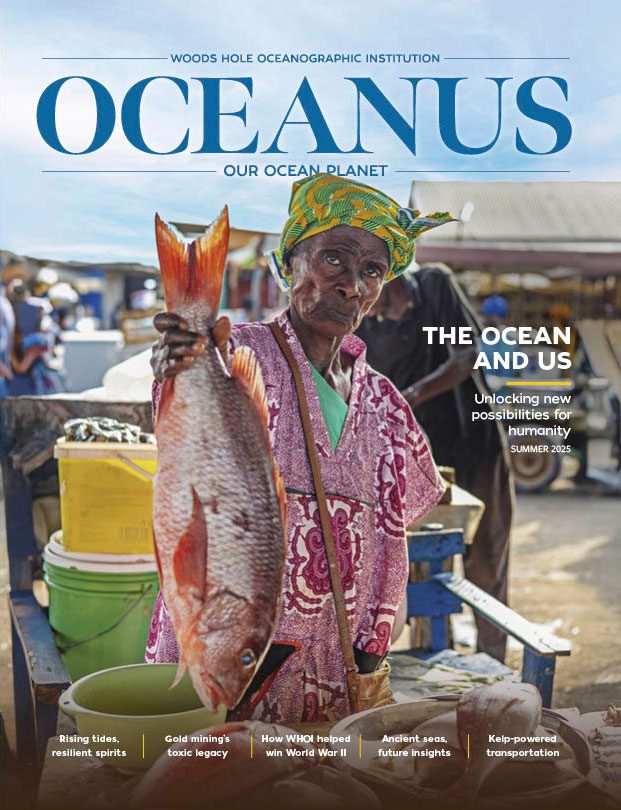
Rebuilding Alvin: Chris German
A series on the people who reassembled the iconic sub
From the beginning of 2011 to May 2013, Alvin, the U.S. science community’s only human-occupied submersible dedicated to deep-sea research, underwent a major overhaul and upgrade to greatly enhance its capabilities. In the end, the iconic sub was redesigned and rebuilt, piece by piece, by a one-of-a-kind team of engineers, technicians, and pilots at WHOI.
Here, Chris German, chief scientist for deep submergence at WHOI from 2006 to 2014, describes the process to add high-definition cameras and LED lighting to enhance the imaging capabilities in the new Alvin.
Since the new Alvin would be equipped with fiber-optic cables, we wanted to take advantage of that expanded bandwidth and upgrade our imaging systems. When I started on the project in 2006, the ‘big new thing’ was high-definition video, which we thought would be great, allowing us to shoot video and also collect two-megapixel still images from the same camera. But by 2010, two-megapixel still images were old hat. The latest ‘big new thing’ becoming available were underwater digital SLR cameras that could take ten-megapixel still images and also shoot HD video. We chose that option for the new Alvin.
We still had to put the cameras into housings that could withstand deep-sea pressure to pass the stringent safety requirements for use with Alvin. The optimal housing would use a clear glass ‘dome’ end-cap for optimal clarity and light transmission. But a higher priority was to guarantee that the housing will not implode, endangering the sub.
Glass presents a problem because, as a randomly ordered, fine-grained material, its properties are not easily quantifiable. Our next-best options were an acrylic that could be machined into a hemisphere, but lacked the clarity of glass; or sapphire, a mineral with hardness close to diamond and excellent optical characteristics, but which was only available as a flat plate, not a dome. It was a tradeoff, and we decided to go with the sapphire window option. It would provide good optical clarity, with just a little distortion in the outer regions of each image, which we could accommodate.
The new sub has five high-def cameras—one above each observer’s forward viewport to record exactly what they can see; two cameras higher up on Alvin’s brow that provide a better overview of the seafloor ‘landscape’; and the new hybrid digital SLR/HDTV camera, initially mounted to point downward beneath Alvin’s basket to collect photos of the seafloor we pass over, which can be merged into photomosaics.
We also added a host of low-power LED lightpacks that can be directed to match each camera’s field of view and don’t put a huge drain on Alvin’s battery capacities. We were keen to see how the cameras and lights would work together at the seafloor when we finally dove in the new Alvin and were thrilled right off the bat. The imagery was immediately better than before, but we wanted to coax the very best out of the systems.
For subsequent dives, we added extra lights on each side of the sub beneath the viewports, but the pièce de résistance was adding a light on one manipulator arm. After dark, we turned on all the sub’s lights to see exactly where the pools of light were landing. I ended up dancing around on the deck, sticking my foot wherever I thought a future observer might see a starfish or vent or whatever—just to make sure that same area would get lit up brightly on all future dives.
Eventually, we will try putting the SLR camera on Alvin’s arm, to get exquisite still images and video closeups, which Alvin has never had before. For that, we have to work on a breakaway for the fiber-optic cable connecting the camera to the sub, in case we ever had to jettison that arm in an emergency, to ensure that one cable couldn’t cause a safety hazard. That’s coming.
Alvin is owned by the U.S. Navy and operated by WHOI. The current upgrade was funded largely by the National Science Foundation, with additional support from private donations to WHOI.
From the Series
Related Articles
- The story of a “champion” submersible
- Robots to the Rescue
- Who is Alvin and what are sea trials?
- 7 Places and Things Alvin Can Explore Now
- The story of “Little Alvin” and the lost H-bomb
- Meet the Alvin 6500 Team: Lisa Smith
- Overhaul to take Alvin to greater extremes
- Meet the Alvin 6500 Team: Rose Wall
- Racing an undersea volcano
Featured Researchers
See Also
- The Once & Future Alvin
- Ready, Set, Dive
- Happy 50th Birthday, Alvin
- Bringing Alvin Back on Board
- Happy 50th Birthday, Alvin website
- Trailblazer in the Ocean Oceanus magazine
- Alvin's Pilots Oceanus magazine
- Newly Upgraded Alvin Submarine Passes Scientific Sea Trials WHOI media release
- Alvin Science Verification Cruise WHOI Blogs & Expeditions
- Alvin Upgrade
- National Deep Submergence Facility at WHOI
- Frequently Asked Questions about Alvin WHOI Ocean Instruments
